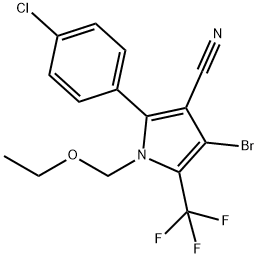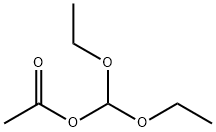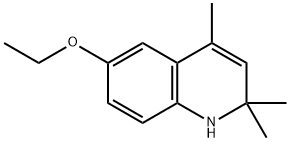Chlorfenapyr , 98% , 122453-73-0
Synonym(s):
4-Bromo-2-(4-chlorophenyl)-1-(ethoxymethyl)-5-(trifluoromethyl)-1H-pyrrol-3-carbonitrile
CAS NO.:122453-73-0
Empirical Formula: C15H11BrClF3N2O
Molecular Weight: 407.61
MDL number: MFCD01631152
| Pack Size | Price | Stock | Quantity |
| 25G | RMB1512.80 | In Stock |
|
| others | Enquire |
PRODUCT Properties
| Melting point: | 91-92° |
| Boiling point: | 443.5±45.0 °C(Predicted) |
| Density | 1.53±0.1 g/cm3(Predicted) |
| storage temp. | Sealed in dry,2-8°C |
| Water Solubility | Insoluble in water |
| solubility | DMSO: 250 mg/mL (613.33 mM) |
| pka | -18.00±0.70(Predicted) |
| form | Solid |
| color | White to Almost white |
| BRN | 6940152 |
| InChI | InChI=1S/C15H11BrClF3N2O/c1-2-23-8-22-13(9-3-5-10(17)6-4-9)11(7-21)12(16)14(22)15(18,19)20/h3-6H,2,8H2,1H3 |
| InChIKey | CWFOCCVIPCEQCK-UHFFFAOYSA-N |
| SMILES | N1(COCC)C(C(F)(F)F)=C(Br)C(C#N)=C1C1=CC=C(Cl)C=C1 |
| CAS DataBase Reference | 122453-73-0(CAS DataBase Reference) |
| NIST Chemistry Reference | Chlorfenapyr(122453-73-0) |
| EPA Substance Registry System | Chlorfenapyr (122453-73-0) |
Description and Uses
Chlorfenapyr is a pyrrole pro-insecticide that is metabolized in vivo into CL 303268 by mixed function oxidases. Chlorfenapyr increases respiratory activity in German cockroaches when used at concentrations ranging from 1 to 10 μg per insect but has no effect on respiration in Sf9 cells when used at concentrations ranging from 1 to 100 μM and does not affect respiration in isolated rat liver mitochondria up to a concentration of 10 μM. Chlorfenapyr is active against a variety of insects including those susceptible and resistant to pyrethroid and organophosphate insecticides, including horn flies (H. irritans) as well as A. culicifacies and A. stephensi mosquitos that carry malaria (LC50s = 2-2.39% suspension impregnated on paper). Chlorfenapyr is lethal to rats with LD50 values of 441 and 1,152 mg/kg for male and female rats, respectively. Formulations containing chlorfenapyr have been used to control termites and in agriculture to control various insects.
Chlorfenapyr is a halogenated pyrrole based pro-insecticide. Chlorfenapyr functions by metabolizing into an active insecticide after entering the host. Chlorfenapyr is used primarily as a means of pes t control on cotton.
Safety
| Symbol(GHS) |   GHS06,GHS09 |
| Signal word | Danger |
| Hazard statements | H302-H331-H410 |
| Precautionary statements | P261-P264-P270-P273-P301+P312-P304+P340+P311 |
| Hazard Codes | T;N,N,T |
| Risk Statements | 22-23-50/53 |
| Safety Statements | 13-36/37-45-60-61 |
| RIDADR | UN 2811 |
| WGK Germany | 3 |
| HS Code | 2933.99.1701 |
| Hazardous Substances Data | 122453-73-0(Hazardous Substances Data) |
| Toxicity | LD50 (single dose) in male, female rats (mg/kg): 223, 459 orally; in rabbits: >2000 dermally (Lovell); LC50 in Japanese carp: 0.5 ppm (Lovell) |




